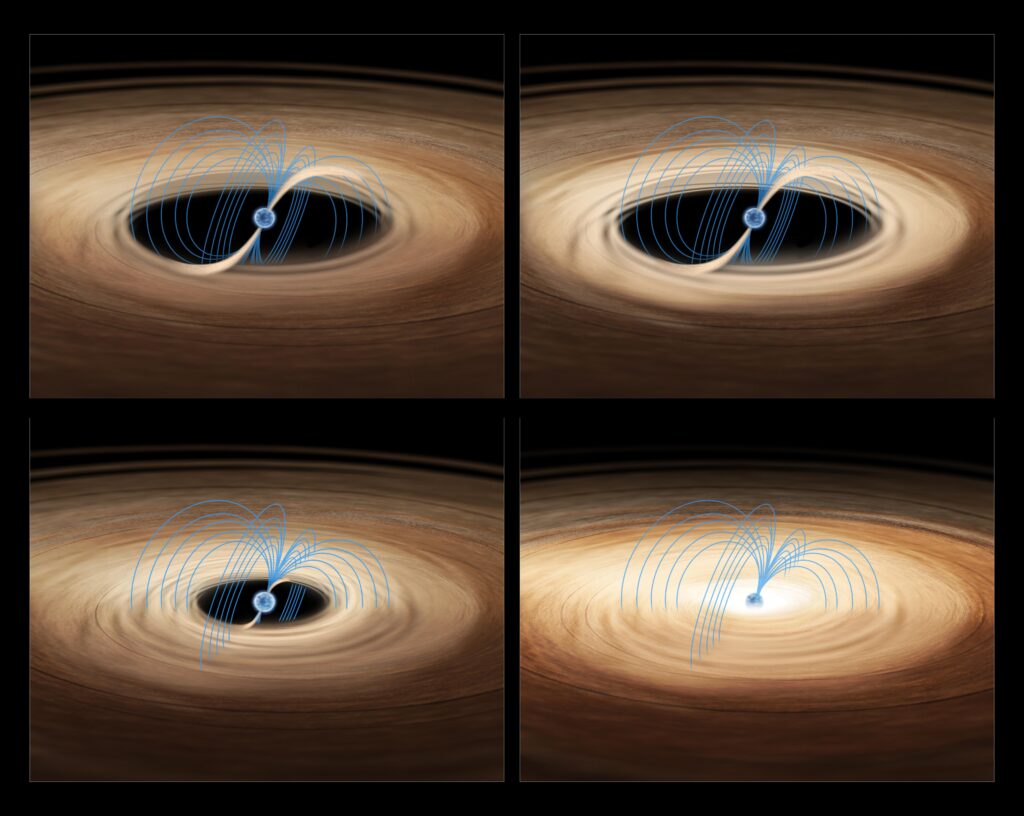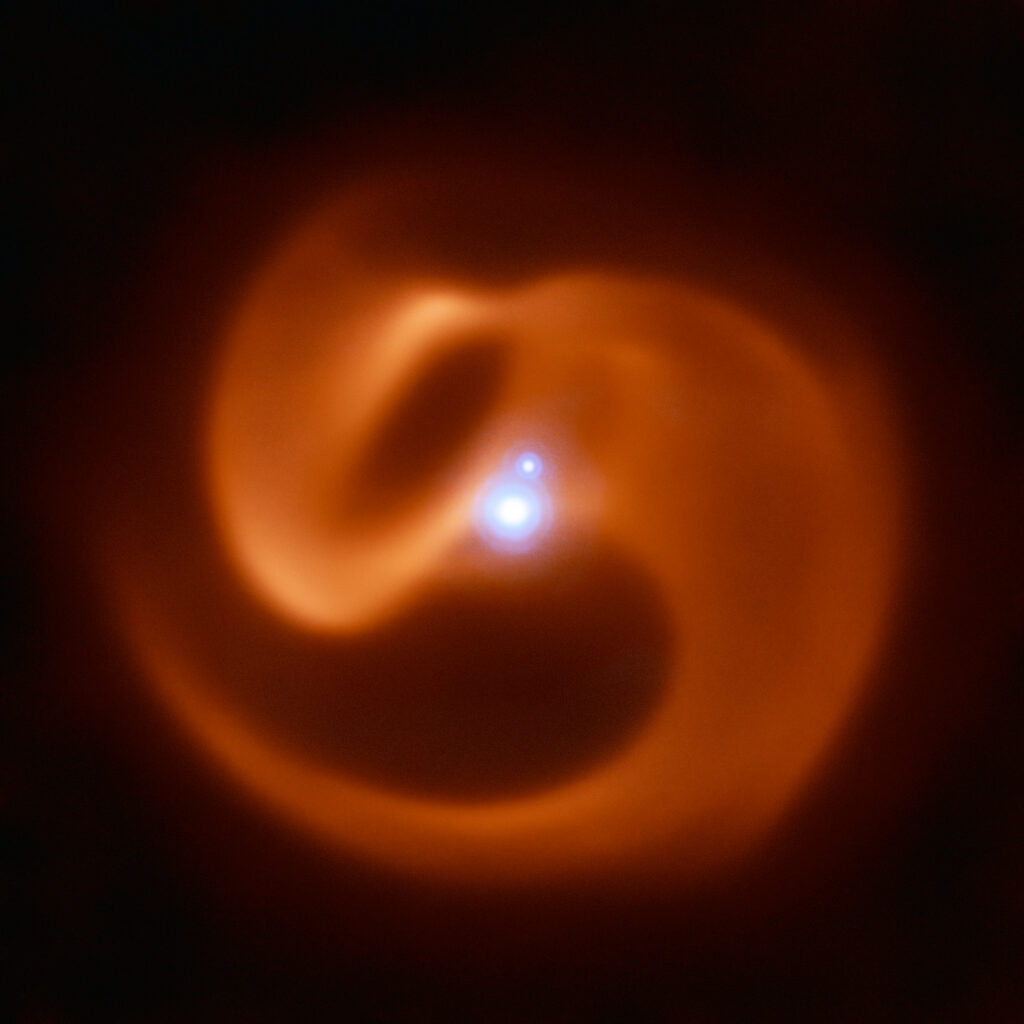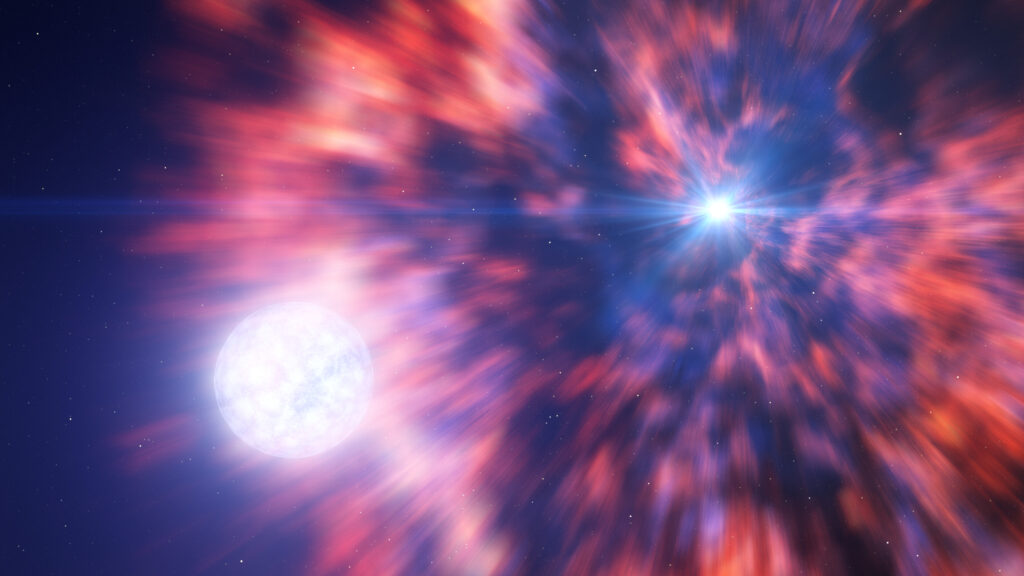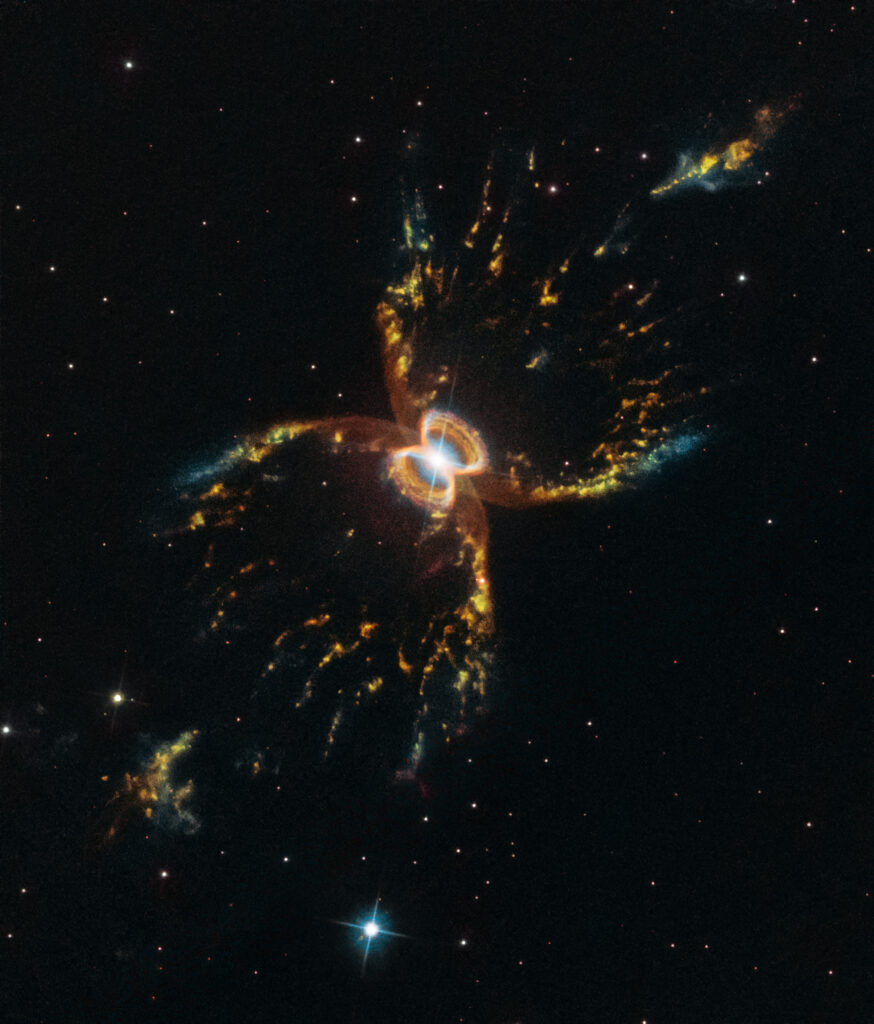CELESTIAL DUOS
© NASA/JPL-Caltech
A binary star, or binary star system, consists of two stars bound together by gravity, orbiting around a common center. Sometimes, binary stars appear as a single point of light in the night sky, but when observed through a telescope, they can be resolved into two distinct stars, known as visual binaries. These systems often have orbital periods spanning centuries or even millennia, making their orbits uncertain or poorly understood. Binary stars can also be detected using indirect methods such as spectroscopy (spectroscopic binaries) or astrometry (astrometric binaries).
When a binary star system’s orbital plane aligns with our line of sight, the stars may eclipse and transit each other, resulting in variations in brightness. These pairs are termed eclipsing binaries, or, when considering other binaries that exhibit brightness changes during their orbits, photometric binaries. In a binary system, the stars may differ in mass, size, or brightness. The larger of the two stars is referred to as the primary star, while the smaller one is known as the secondary star or the companion star.
EVOLUTION

The evolution of binary stars is a complex and fascinating process influenced by gravitational interactions, mass transfer, stellar winds, and other factors.
- Formation: Binary star systems can form through various mechanisms. They may originate from the fragmentation of a molecular cloud during star formation, where two or more protostars form in close proximity. Alternatively, they can form through dynamical interactions in dense stellar environments, such as star clusters. Initially, the stars in a binary system are typically located at a wide separation, and their evolution proceeds independently.
- Stable Evolution: During the stable phase of evolution, both stars evolve independently according to their respective masses. They follow the main sequence, where they burn hydrogen in their cores to produce energy through nuclear fusion. The more massive star evolves more quickly, progressing through its evolutionary stages faster than the lower-mass companion.
- Stellar Interaction: In close binary systems, gravitational interaction between the stars can lead to significant changes in their evolution. When one star expands into its giant phase, it may transfer mass onto its companion through a process known as mass transfer. Mass transfer can occur via a stellar wind or through the transfer of material through an accretion disk, depending on the separation and evolutionary stage of the stars.
- Binary Evolution Scenarios:
- Common Envelope Phase: In some cases, mass transfer can lead to the formation of a common envelope, where both stars share a common gaseous envelope. This phase can lead to the merger of the stars or the ejection of the envelope, resulting in a close binary system.
- Stellar Merger: If the stars in a binary system are close enough, mass transfer may lead to a merger, forming a single, more massive star or a binary system with characteristics different from the original configuration.
- Formation of Exotic Objects: Binary interactions can also lead to the formation of exotic objects such as white dwarfs, neutron stars, or black holes, depending on the masses and evolutionary paths of the stars involved.
- Post-Main Sequence Evolution: Once both stars exhaust their hydrogen fuel in their cores, they evolve off the main sequence. The more massive star may evolve into a red giant or supergiant, while the lower-mass companion may become a white dwarf, neutron star, or even a black hole, depending on its mass.
- Observational Signatures: Observationally, the evolution of binary stars can be inferred from various signatures, including variations in brightness (eclipsing binaries), radial velocity shifts (spectroscopic binaries), and the presence of exotic objects in close binary systems.
TYPES OF BINARY STAR

Binary stars come in various types, each distinguished by their observational characteristics, orbital dynamics, and physical properties. Here are the main types:
VISUAL BINARIES
A visual binary star system consists of two stars whose angular separation is wide enough to be distinguished as a double star through a telescope or powerful binoculars. The ability to resolve these components depends on the angular resolution of the observing instrument. With advancements in angular resolution technology, more visual binaries are being discovered.
The relative brightness of the stars is also crucial, as the glare from a brighter star can obscure the presence of a fainter companion. The brighter star in a visual binary is termed the primary star, while the dimmer one is known as the secondary. In older literature, the fainter secondary star may be referred to as the “comes” (plural: comites) or companion. If both stars have equal brightness, the discoverer’s designation for the primary star is typically adopted.
SPECTROSCOPIC BINARIES
At times, the only indication of a binary star’s existence arises from the Doppler effect affecting its emitted light. In these instances, the binary system comprises two stars whose spectral lines shift from blue to red and vice versa as they move towards and away from us during their orbit around their common center of mass.
In such systems, the stars are typically very close together, and their orbital velocity is notably high. Unless the orbital plane aligns perpendicular to our line of sight, the radial velocities exhibit periodic variations due to the components of orbital velocity along the line of sight. This variation in radial velocity can be measured using a spectrometer, detecting the Doppler shift in the star’s spectral lines. Binaries identified through this method are termed spectroscopic binaries. Many of these binaries cannot be resolved visually, even with the most powerful telescopes available.
In some spectroscopic binaries, spectral lines from both stars are observable, alternating between double and single lines. Such systems are called double-lined spectroscopic binaries (often designated as “SB2”). In contrast, in other systems, only one star’s spectrum is visible, with its spectral lines shifting periodically from blue to red and back again. These stars are termed single-lined spectroscopic binaries (“SB1”).
ECLIPSING BINARIES
An eclipsing binary star system occurs when the orbital plane of the two stars aligns so closely with the observer’s line of sight that mutual eclipses occur between the components. Algol, found in the constellation Perseus, represents one of the most renowned examples of an eclipsing binary within a triple-star system.
These binaries are characterized by variable brightness not due to intrinsic variations in the stars’ luminosity but rather due to the eclipses themselves. The light curve of an eclipsing binary showcases periods of consistent brightness interrupted by periodic drops when one star passes in front of the other. Typically, the brightness decreases twice during the orbit: once as the secondary star eclipses the primary, and again as the primary star eclipses the secondary. The primary eclipse, regardless of which star is being obscured, is defined by the deeper drop in brightness, while any subsequent shallower eclipse is termed the secondary eclipse.
The extent of brightness reduction is influenced by factors such as the relative luminosities of the stars, the portion of the obscured star, and the surface brightness (or effective temperature) of each star. Generally, the primary eclipse is caused by the occultation of the hotter star.
CONTACT BINARIES
Contact binaries are captivating celestial phenomena where two stars, in a binary system, share a common envelope, essentially touching each other. In these systems, the gravitational pull between the stars is so strong that they become tidally locked, with one star’s gravitational pull distorting the shape of the other, creating an egg-like or teardrop shape for each star.
These binary systems offer a unique opportunity to study the intricate dynamics of stellar interactions. Due to their close proximity, contact binaries undergo fascinating phenomena such as mass transfer and common-envelope evolution. Material from one star can transfer onto the surface of its companion, altering its properties and affecting its evolution.
Contact binaries often exhibit variability in their brightness as they rotate and eclipse each other. This variability provides valuable data for astronomers to determine the system’s parameters, such as the stars’ sizes, masses, and orbital characteristics. By analyzing the light curves during eclipses, astronomers can infer crucial information about the stars’ physical properties and their evolutionary stages. The close interaction between the stars can lead to mass loss and the eventual formation of exotic objects such as white dwarfs, neutron stars, or even black holes.
DETACHED BINARIES
Detached binaries represent a fascinating class of binary star systems characterized by their distinct separation between the two stars. Unlike contact binaries, where the stars share a common envelope, detached binaries have individual stellar envelopes that do not interact significantly beyond gravitational attraction.
In detached binaries, each star orbits around its common center of mass without any significant mass transfer or distortion of their shapes. This separation allows for independent evolution of the stars, making detached binaries invaluable laboratories for studying stellar phenomena.
Detached binaries often exhibit variability in their brightness due to eclipses as one star passes in front of the other from the observer’s perspective. These eclipses provide valuable information about the physical characteristics of the stars, such as their sizes and relative orientations.
SEMI-DETACHED BINARIES
Semi-detached binaries are captivating celestial duos where one star fills its Roche lobe, transferring mass to its companion, while the other star retains its individual envelope. This configuration results in a dynamic interaction between the stars, making semi-detached binaries a rich field for studying stellar evolution and binary interactions.
In semi-detached binaries, the primary star, typically the more massive one, expands beyond its Roche lobe, creating a gravitational influence that leads to mass transfer onto the secondary star. This transfer of material can profoundly impact the evolutionary paths of both stars, influencing their masses, compositions, and even their eventual fates.
The mass transfer process in semi-detached binaries often manifests as accretion disks or streams of material flowing between the stars. These phenomena are accompanied by variations in brightness, as the accreting material heats up and emits radiation. Such variability provides astronomers with valuable insights into the physical properties and dynamics of semi-detached binaries.
Observationally, semi-detached binaries present unique challenges and opportunities. Their complex interactions can result in irregular light curves and spectral features, requiring sophisticated observational techniques and theoretical models to interpret. However, these systems also offer a wealth of information about stellar astrophysics, including mass transfer rates, accretion processes, and the effects of binary interactions on stellar evolution.
ASTROMETRIC BINARIES
Astronomers have identified stars that appear to orbit around an apparent void in space. These are known as astrometric binaries, consisting of nearby stars exhibiting a discernible wobble around a specific point in space, despite lacking a visible companion.
Utilizing the same mathematical principles employed for conventional binary systems, astronomers can deduce the mass of the absent companion. The companion may be exceedingly faint, rendering it currently undetectable or obscured by the brilliance of its primary star. Alternatively, it could be an entity emitting minimal or no electromagnetic radiation, such as a neutron star.
The position of the visible star is meticulously monitored and found to fluctuate due to the gravitational influence exerted by its unseen companion. Astronomers repeatedly measure the star’s position relative to more distant stars, scrutinizing for periodic shifts in its position. Typically, this type of observation is feasible for nearby stars, particularly those within a radius of 10 parsecs. Such nearby stars often exhibit relatively high proper motion, causing astrometric binaries to trace an irregular path across the celestial sphere.
DESIGNATIONS

Designations of binary stars involve various systems established by astronomical organizations and conventions.
- Bayer Designations: Introduced by Johann Bayer in his 1603 star atlas “Uranometria,” Bayer designations assign Greek letters (α, β, γ, etc.) to the brightest stars in each constellation, typically in order of apparent magnitude. For binary stars, the brighter component is often designated with the Greek letter followed by the constellation’s genitive (possessive) form, while the fainter component is denoted by the same letter with a subscript “A” (αA) or “B” (αB).
- Flamsteed Numbers: Proposed by John Flamsteed in his “Historia Coelestis Britannica” (1725), Flamsteed numbers provide a numerical designation to stars within each constellation, based on their order of right ascension within the constellation. Binary stars are typically assigned consecutive Flamsteed numbers (e.g., 61 Cygni A and 61 Cygni B) to distinguish between the components.
- Variable Star Designations: Variable stars, including eclipsing binaries, often receive designations from catalogues such as the General Catalogue of Variable Stars (GCVS) or the International Variable Star Index (VSX). Designations may include a combination of letters and numbers, indicating the catalogue, the star’s position in the catalogue, and any additional information about the star’s variability or characteristics.
- HD Catalogue: The Henry Draper Catalogue (HD) provides designations to a large number of stars based on their spectral characteristics and positions. Binary stars listed in the HD catalogue may have a primary designation (e.g., HD 12345) with subsequent notations indicating the components (e.g., HD 12345A, HD 12345B).
- Other Catalogues: Various other catalogues, such as the Hipparcos Catalogue, Tycho Catalogue, and Smithsonian Astrophysical Observatory Star Catalog (SAO), provide designations to stars based on different observational parameters and criteria. Binary stars listed in these catalogues may have designated identifiers specific to the catalogue.
- Modern Designations: With advancements in observational techniques and cataloguing systems, modern designations for binary stars often incorporate a combination of catalogue identifiers, positional data, and spectral characteristics to provide a comprehensive designation unique to each star.
SIGNIFICANCE

Binary stars hold significant importance in various fields of astrophysics, offering insights into stellar evolution, cosmology, and gravitational physics.
STELLAR EVOLUTION
MASS TRANSFER AND INTERACTION
Binary stars provide crucial laboratories for studying mass transfer between stars. In close binary systems, one star can transfer material onto its companion, influencing its evolution. This process can lead to the formation of exotic objects like white dwarfs, neutron stars, or even black holes.
STELLAR PARAMETERS
By observing binary systems, astronomers can accurately determine fundamental stellar parameters such as mass, radius, luminosity, and temperature. These measurements are often challenging for isolated stars but are more readily obtained in binary systems through techniques like radial velocity analysis, photometry, and eclipsing binaries.
GALACTIC AND COSMIC EVOLUTION
STELLAR POPULATIONS
Binary stars contribute significantly to the stellar population of galaxies. Understanding the demographics of binary systems within galaxies provides insights into the formation and evolution of stellar populations over cosmic time.
CHEMICAL ENRICHMENT
Mass transfer and stellar interactions in binary systems play a role in the chemical enrichment of galaxies. Processes such as stellar winds, supernova explosions, and binary mergers contribute to the dispersal of heavy elements into the interstellar medium, shaping the chemical composition of galaxies.
GRAVITATIONAL PHYSICS
TESTS OF GENERAL RELATIVITY
Binary systems containing compact objects like neutron stars or black holes serve as natural laboratories for testing the predictions of general relativity. Observations of binary pulsars, for example, have provided some of the strongest evidence for the existence of gravitational waves and have helped validate key aspects of Einstein’s theory.
DYNAMICS AND ORBITS
Precise measurements of binary star orbits provide valuable data for understanding gravitational dynamics and orbital mechanics. Studying the motion of binary stars allows astronomers to probe the distribution of mass within galaxies, test models of stellar dynamics, and refine our understanding of gravitational interactions.
COSMOLOGICAL DISTANCE MEASUREMENT
BINARY STARS AS STANDARD CANDLES
Certain types of binary stars, such as eclipsing binaries or certain types of cataclysmic variables, can serve as standard candles for distance measurements. By comparing the observed brightness of these binaries with their known intrinsic luminosities, astronomers can determine distances to astronomical objects with high precision, aiding in the calibration of the cosmic distance ladder.
